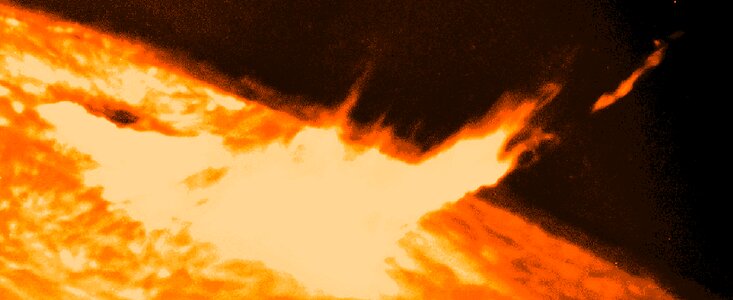New Solis Telescopes To Investigate Solar Activity
26 Febrero 1998
The National Solar Observatory (NSO) announces the start of SOLIS, a state-of-the-art project to investigate space weather and further our understanding of how changes in the Sun affect the Earth's climate and atmosphere. Can we learn to predict when giant explosions will occur on the Sun? Prediction is important because these explosions, which are called "flares" and "coronal mass ejections", propel high-speed particles toward Earth, disrupting radio communication and causing spectacular auroral displays. Understanding and predicting solar activity such as flares is a major goal of SOLIS. The six-million dollar SOLIS project is funded by the National Science Foundation.
Scheduled for completion by the year 2001, the three telescopes of SOLIS will replace existing instruments on Kitt Peak, in Arizona, and Sacramento Peak, in New Mexico. Both of these NSO sites are operated in the national interest by the Tucson-based National Optical Astronomy Observatories (NOAO). Modern networking, remote operation, and automation techniques will provide higher quality data at significant cost savings compared with continued operations of NSO's existing facilities.
SOLIS will provide unique observations of the Sun on a continuous basis for twenty five years, data which are critical to understanding the solar activity cycle, sudden energy releases like flares and mass ejections, as well as subtle changes in the brightness of the Sun and its affect on the Earth's climate. SOLIS (Synoptic Optical Long-term Investigations of the Sun) will investigate the long term nature of these dramatic solar phenomena.
Scheduled completion of SOLIS in 3 years allows for study of the Sun near the height of its 11 year activity cycle. In late spring of 2000, the Sun will exhibit Solar Maximum: an 11-year maximum number of sunspots, an increase in the number of solar flares, and peak energy output at all wavelengths. "Solar variability is the most direct physical link between astronomy and humanity" states Dr. Jack Harvey, project scientist. "SOLIS images will provide a wealth of unique data for solar astronomers. The data will also be posted on the World Wide Web so that anyone who wants can follow changes in the number of sunspots or find out when a flare has occurred." says NOAO director Sidney Wolff.
SOLIS received initial funding from the NSF of $2.9M dollars in January of 1998 and will receive an additional $1.55M in each of the next two years. SOLIS will make use of state-of-the-art technology in computers, electronics, and optics. During construction, NSO will require five additional employees and the services of local companies.
Further information can be obtained on the World Wide Web at URL http://www.nso.noao.edu/solis/
Contactos
Suzanne Jacoby
NOAO Education Officer
Tel: 520-318-8364
Correo electrónico: sjacoby@noao.edu
Dr. Jack Harvey
SOLIS Project Scientist
Tel: 520-318-8337
Correo electrónico: jharvey@noao.edu
Jeremy Wagner
SOLIS Project Manager
Tel: 520-318-8249
Correo electrónico: jwagner@noao.edu




